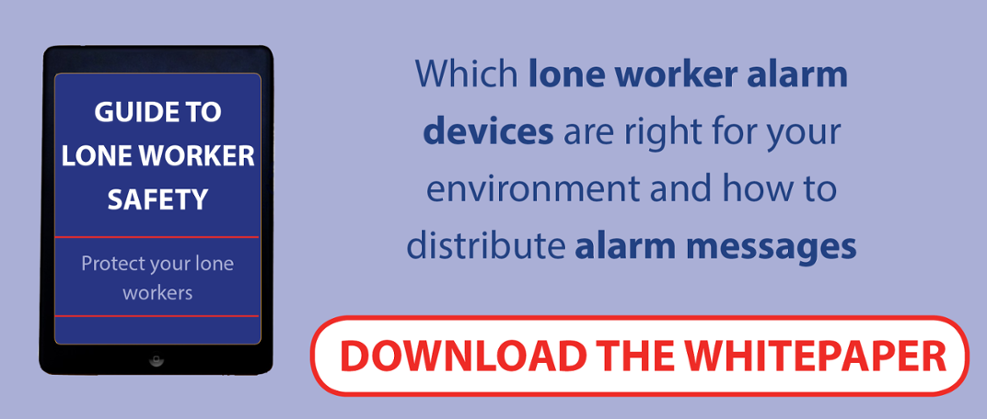
As a team manager, you have plenty on your plate. Lone worker safety might not currently be at the top of the list. Chances are, however, that it should be! Lone workers throughout your facility need to be a top priority when it comes to safety measures--and as a team manager, you're in the ideal position to see that they're getting the care they need, both with regards to the emergency procedures you've put in place and with the day-to-day need to check on lone workers and be sure that they're able to complete their jobs safely.
Lone Worker Accidents are Hard to See
Lone workers aren't necessarily at more risk than anyone else in your facility. They follow the same safety regulations as other employees, and they're very aware of the fact that they're working alone, which may make them more likely to take appropriate precautions. The problem with accidents that occur to lone workers is that they can't be seen. It may take a long time before someone realizes that they're missing or stumbles across them. As a result, it's critical that lone worker safety remain a critical part of your daily responsibilities.
It's Important to Know Who's Responsible
When there are lone workers throughout your facility, it's easy to lose track of who is responsible for them. In some cases, they might not be required to check in with someone on a regular basis. They might be monitored from a distance, with only occasional checks. Within your facility, you need to know who is responsible for checking on lone workers. Whether you take that responsibility on yourself or assign it to someone else, making it a regular part of the daily routine helps ensure that lone workers are protected.
Illness Doesn't Always Come With Warnings
Sometimes, you get warning that you're about to fall ill. In other cases--a sudden dizzy spell; the sudden onset of a stomach bug; even a heart attack or other serious problem--your lone worker may have no warning at all that they're about to be seriously ill. If you have lone workers throughout your facility, monitoring them to ensure that they're remaining healthy and able to complete their daily work responsibilities is for their protection.
You're Legally Responsible for Their Protection
It doesn't matter if the workers in your business are alone or surrounded by colleagues throughout the day. No matter where they are or what they're doing, you're legally responsible for ensuring that their work day can proceed safely. If they are injured or ill on the job, it doesn't matter who is at fault for that problem. What matters is that they receive high-quality care as quickly as possible in order to ensure that they don't suffer complications as a result of their daily isolation. As team manager, it's your responsibility to see to it that these legal responsibilities are taken care of throughout the day. If you want to read more about the current law for lone worker safety, have a read at this blog post.
Your Business Needs a Plan
During any emergency, your business responds according to a clear plan that's been set out for you and explained to every member of the team. From weather-related disasters to equipment breakdowns, you have a clear, understood plan of response. When the time comes to respond to a lone worker emergency, you need a plan in place that will tell employees throughout the company who is responsible for summoning help, what help should be summoned, and what to do when they arrive. Is there a procedure in place for getting medical professionals through security at your workplace? Do you know who on the site has basic first aid training if you need to respond quickly to a medical emergency? Having these procedures in place creates a level of confidence for all of your employees, both those who work alone and those who spend their days working alongside others. As a team manager, you're in the ideal position to know who within your organization is in the best place to take on these key responsibilities. Assigning these roles yourself, including indicating specific individuals to take care of specific tasks, will allow things to flow more smoothly if an emergency does occur.
You're Familiar With Many Job Risks
As a team manager, you work more closely with many of the employees throughout the building than some of the higher-ups who are responsible for creating emergency response plans. That means that in many cases, you have a more solid idea of what each worker needs in order to ensure their safety. You know what risks they're taking, what responsibilities are part of their daily job requirements, and where they travel throughout the day. You have a clear picture of exactly what is needed in order to ensure the safety of lone workers underneath your management and the processes necessary in order to respond in an emergency. That means that lone worker safety should be your top priority. When you understand it, you can better provide for the safety of every member of your team than people who don't spend every day working with them.
Worker safety should be a top priority for any organization. Completely aside from the legal risk, workers who know that their safety is a top consideration are likely to be happier and more satisfied with their jobs overall. By focusing on lone worker safety, you can create a more secure workplace with lone workers who are more confident in their ability to do their jobs every day.





